- Severe weather leads to fallen trees, car crashes and flooding around the Triangle
- New video shows vehicles being swept away in historic, deadly flash floods in SA on June 12
- $40 million to go to underserved SC counties for Hurricane Helene recovery. Here's what you need to know.
- Family honors Air Force veteran Derwin Anderson Jr. after he died in June flash floods
- City of Wilmington addresses flooding on New Centre Drive
A river guardian sees pollution repeat in Florence floods

Rick Dove took to the air to see what the storm had wrought. A longtime advocate for protecting North Carolina’s rivers from pollution, Dove looked down from a small plane on a submerged landscape stitched with swollen streams and rivers and engulfed by newly formed lakes and ponds.
It was not a new scene for Dove, who is 79 and now the Neuse Riverkeeper emeritus and a senior adviser for the international Waterkeeper Alliance. He has conducted aerial surveys after every hurricane to hit eastern North Carolina since 1993. But to him the devastation seems worse this time not for what nature did, but for what humans keep failing to prevent — the flooding of industrial-scale hog and poultry farms situated near rivers.
“The thing that’s so discouraging to me is I see the same thing repeated time and time again,” he said. “Why would North Carolina continue to permit those facilities along the rivers? Why in the world are we letting nature do this to us again and again?”
Riverkeepers in North Carolina have long opposed the storage of hog waste in lagoons prone to being overrun by flood waters. To that pollution source, waste from a growing number of industrial-scale poultry farms has been added.
“Many of them have been put in the very same place the mistake was made with hogs — in flooded areas,” Dove said.
The N.C. Pork Council has reported that only a handful of the state’s 3,300 hog waste lagoons were breached by Florence, inundated by flood waters or caused to overflow from rain.
Dove doubts those numbers because flooding has made it impossible for some hog farmers to inspect their lagoons. During his flights Monday and again on Tuesday, he said, “I saw multiple lagoons that were submerged. I saw many, many (hog) confinement buildings and lagoons that were islands in what looked like a huge river or lake.”
Especially galling to Dove was the sight of liquid hog waste being sprayed Monday on already saturated fields. That waste, he said, flows directly off the fields into waterways. The Waterkeeper Alliance has posted photos from its overflights of eastern North Carolina.
Leakage from lagoons is offset by the diluting effect of the flood waters, and most of the solid waste remains in the lagoons as sludge. It’s also notable that flooded municipal waste treatment plants have released far more waste during Florence than hog lagoons.
Dove acknowledges that, but notes that the municipal plants have been improved with new technology and their discharges reduced. Meanwhile, the hog industry continues to use the same lagoon-and-spray disposal method it used 20 years ago, which contributes to river pollution even in good weather.
Dove doesn’t hold hog farmers responsible for the waste mess. He said the farmers, who raise the hogs under contract, are doing what they can afford.
But Smithfield Foods, the largest owner of hogs in North Carolina, can afford to have its contract farmers install more effective waste disposal methods, and has chosen not to. He thinks recent successful lawsuits filed by hog farm neighbors and massive flooding from the second hurricane in two years may persuade the industry to invest in better disposal methods.
“I’m hoping the perfect storm is coming for this industry to make it do the right thing,” he said.
Dove has been protective of North Carolina’s rivers for so long his colleagues call him “Old Man River.” But despite the floods and growing pollution from industrialized farming, he still thinks his vigilance from the sky can lead to beneficial changes in the land and rivers below:
“I hope what I’ve seen and have reported results in the kind of change that make eastern North Carolina the kind of place it used to be and can be again.”
Barnett: 919-829-4512, nbarnett@newsobserver.com.